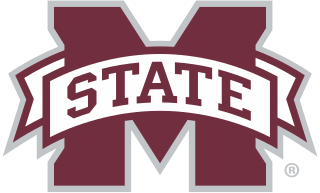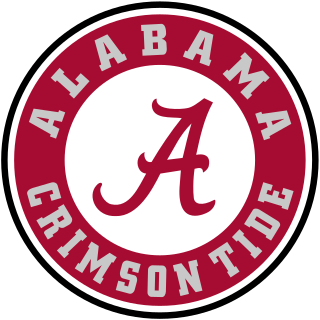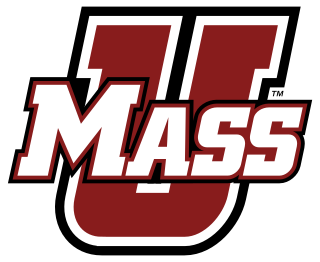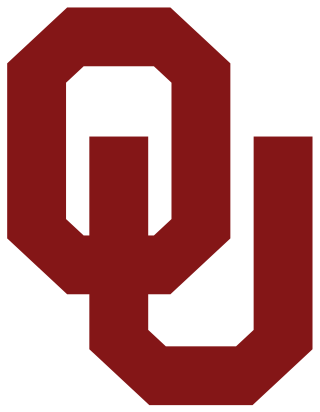Related Research Articles

The Sugar Bowl is an annual American college football bowl game played in New Orleans, Louisiana. Played annually since January 1, 1935, it is tied with the Orange Bowl and Sun Bowl as the second-oldest bowl games in the country, surpassed only by the Rose Bowl Game.

The Peach Bowl is an annual college football bowl game played in Atlanta, Georgia, since December 1968. Since 1997, it has been sponsored by Chick-fil-A and is officially known as the Chick-fil-A Peach Bowl. From 2006 to 2013, it was officially referred to as simply the Chick-fil-A Bowl. The winner of the bowl game is awarded the George P. Crumbley Trophy, named after the game's founder George Crumbley.

The UCF Knights football team represents the University of Central Florida (UCF) in the sport of American football. The Knights compete in the Division I Football Bowl Subdivision (FBS) of the National Collegiate Athletic Association (NCAA) and are a member of the Big 12 Conference, making UCF the youngest school among the Power Five conferences. Their head coach is Gus Malzahn. The Knights play their home games at the 45,000-seat FBC Mortgage Stadium, which is located on UCF's main campus in Orlando, Florida, United States.

The LSU Tigers football program, also known as the Fighting Tigers, represents Louisiana State University in college football. The Tigers compete in the Football Bowl Subdivision (FBS) of the National Collegiate Athletic Association (NCAA) and the Western Division of the Southeastern Conference (SEC).

The Alabama Crimson Tide football program represents the University of Alabama in the sport of American football. The team competes in the Football Bowl Subdivision (FBS) of the National Collegiate Athletic Association (NCAA) and the Western Division of the Southeastern Conference (SEC). The team is currently led by Kalen DeBoer. The Crimson Tide is among the most storied and decorated football programs in NCAA history. Since beginning play in 1892, the program claims 18 national championships, including 13 wire-service national titles in the poll-era, and five other titles before the poll-era. From 1958 to 1982, the team was led by Hall of Fame coach Paul "Bear" Bryant, who won six national titles with the program. Alabama then had a dominant run under head coach Nick Saban between 2007 and 2023, resulting in six further national titles.

The Kentucky Wildcats football program represents the University of Kentucky in the sport of American football. The Wildcats compete in the Football Bowl Subdivision (FBS) of the National Collegiate Athletic Association (NCAA) and the Eastern Division of the Southeastern Conference (SEC). The Wildcats play their home games at Kroger Field in Lexington, Kentucky and are led by head coach Mark Stoops.

Arthur Gustavo Malzahn III is an American football coach. He is currently the head coach at the University of Central Florida (UCF). He was the head football coach at Auburn University from 2013 to 2020. He helped lead the 2010 Auburn Tigers to a National Championship as the team's offensive coordinator. As head coach at Auburn, he led the team to a SEC Championship win and an appearance in the 2014 National Championship. Malzahn has coached Heisman winner Cam Newton and two Heisman finalists: Nick Marshall and Tre Mason. During Malzahn's tenure at Auburn, he qualified as the second-longest tenured head coach at one school in the SEC, behind Nick Saban. Out of active head coaches, Malzahn also holds the best record against coach Saban.

The Mississippi State Bulldogs football program represents Mississippi State University in the sport of American football. The Bulldogs compete in the Football Bowl Subdivision (FBS) of the National Collegiate Athletic Association (NCAA) and the Western Division of the Southeastern Conference (SEC). They also have won one SEC championship in 1941 and a division championship in 1998. The Bulldogs have 26 postseason bowl appearances. The program has produced 38 All-Americans, 171 All-SEC selections, and 124 NFL players. The Bulldogs’ home stadium, Davis Wade Stadium at Scott Field, is the second oldest in the NCAA Division I FBS.

The 2007 Navy vs. Notre Dame football game ended the longest all-time college football consecutive wins streak by one team over another. On November 3, 2007, the Navy Midshipmen defeated the Notre Dame Fighting Irish 46–44 in triple-overtime at Notre Dame's home field, Notre Dame Stadium in South Bend, Indiana. Notre Dame came into this annual game with 43 straight wins against Navy since the last loss against Heisman Trophy winner Roger Staubach in 1963. With the win, Navy improved to 5–4 and Notre Dame fell to 1–8 on the season.
The 1967 NCAA University Division football season was the last one in which college football's champion was crowned before the bowl games. During the 20th century, the NCAA had no playoff for the major college football teams in the University Division, later known as Division I-A and now as the Division I Football Bowl Subdivision (FBS).

The 2008 Alabama Crimson Tide football team represented the University of Alabama in the 2008 NCAA Division I FBS football season. It was the Crimson Tide's 114th overall season, 75th season as a member of the Southeastern Conference (SEC) and its 17th within the SEC Western Division. The team was led by head coach Nick Saban, in his second year, and played their home games at Bryant–Denny Stadium in Tuscaloosa, Alabama.

The UMass Minutemen football team represents the University of Massachusetts in the NCAA Division I Football Bowl Subdivision (FBS). The Minutemen compete as an FBS independent. Since 1965, their home games have been played at Warren McGuirk Alumni Stadium on the university's campus in Hadley, Massachusetts.
The Louisiana–Monroe Warhawks football program is a college football team that represents the University of Louisiana at Monroe (ULM).

The 2015 Arkansas Razorbacks football team represented the University of Arkansas during the 2015 NCAA Division I FBS football season. The Razorbacks played their home games at Donald W. Reynolds Razorback Stadium in Fayetteville and War Memorial Stadium in Little Rock. They competed as a member of the Western Division of the Southeastern Conference. Arkansas was led by third-year head coach Bret Bielema. Dan Enos served his first season as offensive coordinator, replacing Jim Chaney who left for a job with Pittsburgh. Enos was previously the head coach of Central Michigan.

The Oklahoma Sooners football statistical leaders are individual statistical leaders of the Oklahoma Sooners football program in various categories, including passing, rushing, receiving, total offense, defensive stats, and kicking. Within those areas, the lists identify single-game, single-season, and career leaders. The Sooners represent the University of Oklahoma (OU) in the NCAA Division I FBS Big 12 Conference through the 2023 season, after which they will join the Southeastern Conference (SEC).
The 2016 Syracuse vs. Pittsburgh football game was a regular-season college football game between the Syracuse Orange and the Pittsburgh Panthers, played on November 26, 2016 at Heinz Field in Pittsburgh, Pennsylvania. The game held the record for the most combined points scored in an NCAA Division I Football Bowl Subdivision (FBS) regulation game with 137 total points, breaking the previous record by a single point. The record was broken on November 5, 2022 when the SMU Mustangs defeated the Houston Cougars 77–63 for a combined 140 points.

The 2018 LSU vs. Texas A&M football game was a regular-season college football game played between the LSU Tigers and the Texas A&M Aggies. The game was played on November 24, 2018, at Kyle Field in College Station, Texas, and was the final regular-season game for both teams. The game set multiple National Collegiate Athletic Association (NCAA) records, including the most combined points scored (146) in a Division I Football Bowl Subdivision (FBS) football game. The record was previously held by a game played between Western Michigan and Buffalo on October 7, 2017, which had 139 combined points over seven overtimes. The 2018 LSU–Texas A&M game went likewise to seven overtimes and lasted nearly five hours, tying the NCAA record for longest football game with four others. The 146 combined points are currently the second most in college football history since the NCAA started keeping records in 1937, behind the 161 points scored in a 2008 NCAA Division II game between Abilene Christian and West Texas A&M of the Lone Star Conference. The game also holds the record for most points scored in a Southeastern Conference game.
The 2021 NCAA Division I FBS football season was the 152nd season of college football in the United States organized by the National Collegiate Athletic Association (NCAA) at its highest level of competition, the Football Bowl Subdivision. The regular season began on August 28, 2021, and ended on December 11, 2021. The postseason began on December 17, with the main games ending on January 10, 2022, with the College Football Playoff National Championship at Lucas Oil Stadium in Indianapolis, and the all-star portion of the post-season concluding with the inaugural HBCU Legacy Bowl on February 19, 2022. It was the eighth season of the College Football Playoff (CFP) system. It was the first time since 2016 that no major team finished the season undefeated as the Cincinnati Bearcats, the season's last undefeated team, were defeated in the 2021 Cotton Bowl Classic.
References
- ↑ DeLassus, David. "Princeton Yearly Results (1869)". College Football Data Warehouse. Archived from the original on February 13, 2010. Retrieved April 4, 2011.
- ↑ "The Birthplace of College Football". www.rutgers.edu. Retrieved May 8, 2022.
- ↑ Danzig, Allison (1956). The History of American Football: Its Great Teams, Players, and Coaches. Englewood Cliffs, N.J.: Prentice-Hall, Inc. p. 9.
- ↑ "No Christian End!" (PDF). The Journey to Camp: The Origins of American Football to 1889. Professional Football Researchers Association. Retrieved January 26, 2010.
- ↑ "THIS DATE IN HISTORY: First football game was May 14, 1874". McGill University. May 14, 2012.
- ↑ Danzig, pp. 9-10.
- ↑ Dupont, Kevin Paul (September 23, 2004). "Gridiron gridlock: Citing research, Tufts claims football history is on its side". The Boston Globe.
- ↑ Danzig, pp. 10-14.
- ↑ "Kentucky New Era - Google News Archive Search". news.google.com. Retrieved May 8, 2022.
- ↑ Danzig, p. 15-16.
- ↑ "Clipped From The Boston Globe". The Boston Globe. November 1, 1881. p. 1. Retrieved May 21, 2022.
- ↑ "Rivalry 150 – Lafayette vs. Lehigh".
- ↑ DeLassus, David. "Yale Yearly Results (1880–1884)". College Football Data Warehouse. Archived from the original on February 13, 2010. Retrieved April 4, 2011.
- ↑ "Good Night". Washington Post . November 18, 2006. Retrieved April 4, 2011.
- ↑ "This Day in Black History: Dec. 27, 1892". BET. December 27, 2012. Retrieved August 2, 2017.
- ↑ O'Sullivan, Dan (December 13, 2002). "Bowl Championship Series – 1902 – Michigan 49, Stanford 0". ESPN.com/BCSfootball.com . Retrieved April 4, 2011.
- ↑ Boyles, Bob and Guido, Paul, 50 Years of College Football, page 23, 2007
- ↑ "Marching Band History". University of Illinois Urbana-Champaign. Archived from the original on May 12, 2011. Retrieved April 6, 2011.
- ↑ "The History of Homecoming". ACTIVE.com. Archived from the original on October 19, 2012. Retrieved April 6, 2011.
- ↑ "100 years ago: Football fans enjoy mechanized reproduction of KU-MU game". Lawrence Journal-World . November 27, 2011. Retrieved December 27, 2011.
- ↑ "Notre Dame vs. Army 1913 – the Game". October 31, 2013.
- ↑ Davis, Parke H. (October 15, 1916). "Yellow Jackets-Cumberland Score Was Record One; Tops the List According to Statistics Compiled Showing All Scores Past the Century Mark". The Atlanta Journal-Constitution. pp. A3.
- ↑ Sciullo Jr, Sam, ed. (1991). 1991 Pitt Football: University of Pittsburgh Football Media Guide. Pittsburgh, PA: University of Pittsburgh Sports Information Office. p. 116.
- ↑ "ESPN ranks 1921 Centre-Harvard game among college football's greatest upsets". Archived from the original on December 17, 2004.
- ↑ "Football Squads Begin practice". The Kingsport Times. September 14, 1923.
- ↑ cf. Bill Traughber. "CHC- Vandy Ties Michigan in 1922". Archived from the original on February 1, 2016.
- ↑ "Princeton-Chicago football game is broadcast across the country".
- ↑ "A look back at 'the game that changed the South,' as Alabama altered perception with 1st national title". AL.com. January 2015.
- ↑ Beachler, Eddie (October 3, 1939). "Tech, Pitt, Dukes in Good Condition for Next Test". The Pittsburgh Press . Retrieved February 12, 2011.
- ↑ Cook, Beano (October 6, 2006). "Beano Cook's top 10 moments in college football". ESPN . Retrieved July 1, 2013.
- ↑ Bassetti, John (August 1, 1999). "First penalty flag has its roots in YSU football". The Youngstown Vindicator.
- 1 2 "Games Where #1 Faced #2". Archived from the original on August 28, 2008.
- ↑ "Chester M. Pierce made history on the field and in the classroom". GoCrimson.com.
- ↑ Bodani, Frank (December 27, 2019). "Penn State in the Cotton Bowl: How the most important game still resonates". York Daily Record. Retrieved July 30, 2023.
- ↑ Pedersen, Paul M.; Parks, Janet B.; Quarterman, Jerome; Thibault, Lucie, eds. (2011). Contemporary Sport Management (4th ed.). Champaign, IL: Human Kinetics. p. 50. ISBN 978-0-7360-8167-2 . Retrieved March 25, 2012.
- ↑ "History of the Rose Bowl Game". Tournament of Roses. October 3, 2017.
- ↑ Thamel, Pete (January 1, 2006). "Grier Integrated a Game and Earned the World's Respect". New York Times. Retrieved April 10, 2011.
- ↑ "Ending The Streak (1957 vs. Oklahoma)". University of Notre Dame.
- ↑ Historic Facts about the Rose Bowl Stadium Archived March 26, 2010, at the Wayback Machine
- ↑ Greenya, John. "Black Man on a White Field". Washington Post.
- ↑ Gelston, Dan (n.d.). "Army-Navy, Instant Replay, Tony Verna, 45 Years Later ..." The Associated Press . Archived from the original on August 5, 2010. Retrieved December 24, 2009– via Los Angeles Daily News.
- ↑ "Pioneers of Integration in the SEC" (PDF). 2018 UK Football Record Book. Kentucky Wildcats. Archived from the original (PDF) on September 13, 2018. Retrieved September 12, 2018.
- ↑ Maraniss, Andrew (2014). Strong Inside: Perry Wallace and the Collision of Race and Sports in the South. Nashville, TN: Vanderbilt University Press. p. 221. ISBN 9780826520241.
- ↑ Nunez, Tammy (May 15, 2013). "Tulane community mourns death of SEC pioneer Stephen Martin". The Times-Picayune . Retrieved July 13, 2013.
- ↑ Kindred, Dave. "The Forgotten Trailblazer". Sports on Earth. Archived from the original on January 28, 2018. Retrieved November 5, 2013.
- ↑ Coach of the Year (2007) – hosted by Keith Jackson Archived November 30, 2006, at the Wayback Machine "Keith Jackson has been broadcasting college football since 1952 and has reported games like the “Game of the Century” between UCLA and USC in 1967."
- ↑ Hofstetter, Adam B. (2007). Football in the Pac-10 . The Rosen Publishing Group. ISBN 978-1-4042-1922-9.
- ↑ Crosstown rivalry over the years – USC-UCLA, 1967. Los Angeles Times. In 1967, the L.A. rivals played what was billed as the Game of the Century
- ↑ Maisel, Ivan (October 14, 2011). "Ole Miss-Alabama game still legendary". ESPN.com . Retrieved October 15, 2011.
- ↑ Dargis, Manohla (November 18, 2008). "Back in 1968, When a Tie Was No Tie". New York Times. Retrieved August 28, 2015.
Take another look at the coyly, cleverly enigmatic title, borrowed from the famous headline in The Harvard Crimson.
- ↑ Freedman, Samuel G. "College Football's Real Racial Breakthrough Was FAMU vs. Tampa". The Root. Retrieved July 18, 2018.
- ↑ "Hooper: Tampa deserves praise for historic 1969 game between FAMU and UT". October 30, 2013. Retrieved July 18, 2018.
- ↑ Freedman, Samuel G. (October 26, 2009). "Southern White Teams Just Didn't Play Black Ones, but One Game Ended All That". The New York Times. Retrieved July 18, 2018.
- ↑ Yaeger, Don; Sam Cunningham, John Papadakis (2006). Turning of the Tide: How One Game Changed the South . Center Street. ISBN 1-931722-94-3.
{{cite book}}: CS1 maint: multiple names: authors list (link) - ↑ Robbins, Lenn. "Trojans Have Horses". New York Post . Retrieved August 26, 2007.
- ↑ Forde, Pat (August 27, 2007). "The Dash is off and running". ESPN.com. Retrieved August 28, 2007.
- ↑ "The night TCU-Baylor rivalry met tragedy". August 17, 2015.
- ↑ "Historical Newspapers from 1700s-2000s". February 22, 2024.
- ↑ Williams, Jeff (August 20, 2015). "NCAA Records – 2014" (PDF). NCAA. NCAA.org. Retrieved August 20, 2015.
- ↑ Pittman's Death Shocks Conference November 1, 1971 The Reading Eagle Detroit(?), Michigan https://news.google.com/newspapers?nid=1955&dat=19711101id=mgsrAAAAIBAJ&sjid=XZoFAAAAIBAJ&pg=4555,444540&hl=en
- ↑ "Blast From the Past: Minnesota 11-15-1975". November 15, 2014. Retrieved August 20, 2015.
- ↑ "Back in the day: 40 years ago, Morgan State and Grambling played in Tokyo". Andscape . September 23, 2016.
- ↑ "Dream come true! NU ends 34-game nightmare". Chicago Tribune. February 22, 2024.
- ↑ Schlabach, Mark (August 21, 2007). "Michigan seniors ready to erase some dubious zeros". ESPN.com . Retrieved September 1, 2007.
- ↑ "ESPN.com – E-Ticket: The Night College Football Went To Hell". ESPN.com.
- ↑ "OTL: Fifth-and-goal". ESPN.com.
- ↑ "SEC Storied: The Play That Changed College Football". secsports.com.
- ↑ "Miami's Streak Is Ended". Los Angeles Times. September 25, 1994.
- ↑ Rittenberg, Adam. "Sometimes history isn't always pretty as the CFB's last tie shows".
- ↑ Whiteside, Kelly (August 25, 2006). "Overtime system still excites coaches". USA Today. Archived from the original on September 6, 2010. Retrieved September 25, 2009.
- ↑ Ley, Bob (October 15, 2000). "Page 2-Outside the Lines: Heather Sue Mercer suit". ESPN.com . Retrieved April 19, 2011.
- ↑ "8 Overtimes Are Enough For B-cc". tribunedigital-orlandosentinel.
- ↑ "Prairie View A&M Ends 80-Game Streak". Los Angeles Times. September 27, 1998.
- ↑ "Martin first female to play, score in Division I". ESPN.com . August 31, 2001. Retrieved May 15, 2011.
- ↑ "History Maker". CNN Sports Illustrated. December 26, 2002. Retrieved October 30, 2009.
- ↑ "The University of New Mexico Official Athletic Site". Archived from the original on August 10, 2010. Retrieved October 18, 2010. (2–2 PATs, New Mexico vs. Texas State, 8/30/03)
- ↑ Carroll, Andrew (September 14, 2000). "UWA's Tonya Butler aims for NCAA history". The Tuscaloosa News. p. C1. Retrieved November 25, 2011.
- ↑ Rosen, Karen (October 17, 2003). "Pioneer still gets her football kicks". The Atlanta Journal-Constitution. p. 8D.
- ↑ Wetzel, Dan (September 1, 2007). "Hail to the victors". Yahoo! Sports . Retrieved September 1, 2007.
- ↑ "Notre Dame's NCAA-record 43-game win streak over Navy ends". ESPN. Retrieved November 4, 2007.
- ↑ "Video of the play". ESPN.com. The Disney Company. Archived from the original on October 29, 2007. Retrieved October 30, 2007.
- ↑ "Drake To Play First American Football Game In Africa" (Press release). Drake Bulldogs. September 1, 2010. Retrieved September 1, 2010.
- ↑ "John Gagliardi, winningest coach in college football history, dies at 91". ESPN. Retrieved July 10, 2018.
- ↑ "SJU Coasts to 55–10 Win at Hamline". St. John's University Johnnies Athletics. February 14, 2024.
- ↑ "0-0 in regulation, Wake Forest beats Virginia Tech, 6-3 in 2OT". USA Today.
- ↑ "Portland State Vikings make history, knock off North Texas 66–7". The Oregonian. October 11, 2015.
- ↑ "Record crowd watches No. 17 Vols beat Virginia Tech 45–24". ESPN.com. September 10, 2016. Retrieved September 11, 2016.
- ↑ "Syracuse gives up most points ever in game in Pitt's wild 76–61 victory". ESPN.com. November 26, 2016. Retrieved November 27, 2016.
- ↑ Bailey, Stephen (November 30, 2016). "Syracuse football vs. Pittsburgh: Top PFF grades from highest-scoring game in FBS history". www.syracuse.com. The Post-Standard.
- ↑ Anderson, Mark (September 3, 2017). "Howard shocks Rebels as 45-point underdogs". Las Vegas Review-Journal. Retrieved September 3, 2017.
- ↑ Steinberg, Dan. "Howard and Caylin Newton stun UNLV in one of the biggest upsets in college football history". Washington Post. Retrieved September 4, 2017.
- ↑ Kirshner, Alex (October 7, 2017). "WMU beats Buffalo in record-tying 7 overtimes, setting new FBS scoring record". SB Nation. Retrieved October 7, 2017.
- ↑ Lyles, Harry (November 25, 2018). "A new FBS scoring record, a tied FBS overtime record, a premature Gatorade bath, questionable calls, amazing catches, and more". SB Nation. Retrieved November 25, 2018.
- ↑ "Virginia Tech gets 6OT win over UNC in longest game in ACC history". ESPN.com. Associated Press. October 19, 2019. Retrieved November 24, 2019.
- ↑ "Penn State vs. Illinois score: Illini upset No. 7 Nittany Lions in first 9OT game in FBS history". CBSSports.com. October 23, 2021. Retrieved October 23, 2021.
- ↑ "Mordecai's 9 passing TDs send SMU past Houston 77-63". espn.com. Retrieved November 6, 2022.
- ↑ Goeckel, Christian (January 9, 2023). "Final: Georgia Blasts TCU; Claims Back-to-Back Titles". Sports Illustrated Georgia Bulldogs News, Analysis and More. Retrieved January 10, 2023.
- ↑ "Georgia breaks national championship points record in blowout vs. TCU". Saturday Down South. January 9, 2023. Retrieved January 10, 2023.
- ↑ "Fresno State Athletics Partners With Univision for Historic College Football Broadcast" (Press release). Fresno State Bulldogs. August 15, 2023. Retrieved August 18, 2023.
- ↑ Scarborough, Alex (September 23, 2023). "Haley Van Voorhis becomes first woman non-kicker to play in NCAA football game". ESPN.com. Retrieved September 23, 2023.